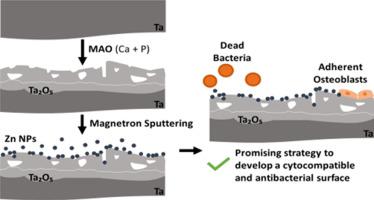Biomaterials Advances ( IF 7.9 ) Pub Date : 2020-12-01 , DOI: 10.1016/j.msec.2020.111761 Luísa Fialho , Liliana Grenho , Maria H. Fernandes , Sandra Carvalho

|
Implant surfaces with cytocompatible and antibacterial properties are extremely desirable for the prevention of implant's infection and the promotion of osseointegration. In this work, both micro-arc oxidation (MAO) and DC magnetron sputtering techniques were combined in order to endow tantalum-based surfaces with osteoblastic cytocompatibility and antibacterial activity. Porous Ta2O5 layers containing calcium (Ca) and phosphorous (P) were produced by MAO (TaCaP) to mimic the bone tissue morphology and chemical composition (Ca/P ratio close to 1.67). Furthermore, zinc (Zn) nanoparticles were deposited onto the previous surfaces by DC magnetron sputtering without or with an additional thin carbon layer deposited over the nanoparticles (respectively, TaCaP-Zn and TaCaP-ZnC) to control the Zn ions (Zn2+) release. Before osteoblastic cell seeding, the surfaces were leached for three time-points in PBS. All modified samples were cytocompatible. TaCaP-Zn slightly impaired cell adhesion but this was improved in the samples leached for longer immersion times. The initial cell adhesion was clearly improved by the deposition of the carbon layer on the Zn nanoparticles, which also translated to a higher proliferation rate. Both Zn-containing surfaces presented antibacterial activity against S. aureus. The two surfaces were active against planktonic bacteria, and TaCaP-Zn also inhibited sessile bacteria. Attributing to the excellent in vitro performance of the nanostructured Ta surface, with osteoconductive elements by MAO followed by antimicrobial nanoparticles incorporation by magnetron sputtering, this work is clearly a progress on the strategy to develop a new generation of dental implants.
中文翻译:

具有骨传导元素和抗菌核壳纳米粒子的多孔氧化钽:用于牙科植入物的新一代材料
具有细胞相容性和抗菌性的植入物表面对于防止植入物的感染和促进骨整合是非常需要的。在这项工作中,微弧氧化(MAO)和直流磁控溅射技术相结合,以使钽基表面具有成骨细胞的细胞相容性和抗菌活性。多孔Ta 2 O 5通过MAO(TaCaP)产生包含钙(Ca)和磷(P)的层,以模仿骨骼组织的形态和化学成分(Ca / P比接近1.67)。此外,锌(Zn)纳米颗粒通过直流磁控溅射沉积在先前的表面上,而没有或在纳米颗粒上分别沉积有额外的薄碳层(分别为TaCaP-Zn和TaCaP-ZnC)以控制Zn离子(Zn 2+) 释放。在成骨细胞播种之前,将表面浸入PBS中三个时间点。所有修饰的样品都是细胞相容的。TaCaP-Zn稍微损害了细胞粘附性,但浸出时间更长的浸没样品中的粘附性得到了改善。通过在锌纳米颗粒上沉积碳层,明显改善了初始细胞粘附,这也转化为更高的增殖速率。含锌的两个表面均表现出对金黄色葡萄球菌的抗菌活性。这两个表面对浮游细菌具有活性,而TaCaP-Zn也抑制无柄细菌。归因于出色的体外 具有纳米结构的Ta表面的性能,MAO的骨传导元素,磁控溅射结合的抗菌纳米颗粒的结合,这项工作显然是开发新一代牙科植入物的策略上的一项进步。


























 京公网安备 11010802027423号
京公网安备 11010802027423号